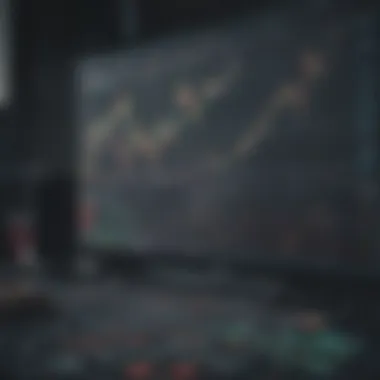Top Futures Trading Bots: A Detailed Overview


Intro
In the brisk world of cryptocurrency, the landscape of investment is undergoing rapid transformations. With volatility at the heart of market movements, traders are continuously striving for an edge, and here lies the rising significance of futures trading bots. These automated systems aim to take the guesswork out of trading, offering features like strategy execution, real-time analysis, and much more.
As the technology matures, the choices for traders have broadened, making it both advantageous and overwhelming. Navigating through this sea of options prompts the need for clarity, as selecting the right bot can greatly influence financial outcomes. This comprehensive guide will peel back the layers of the leading futures trading bots available today, delving into their capabilities, benefits, and potential shortcomings. Whether you are a seasoned trader or a newcomer to the crypto space, understanding these tools can significantly enhance your trading experience, allowing for more informed and strategic decision-making.
Here, we aim to clarify what to look for in a trading bot, how these systems operate, and what practices can maximize their potential, ensuring that you can trade with confidence.
Understanding Futures Trading Bots
Futures trading bots have grown increasingly influential in modern trading strategies, reshaping how traders engage with the markets. By leveraging automation, these tools allow traders to execute orders swiftly, without the delay caused by manual input. For individuals caught up in the whirlwind of market fluctuations, trading bots provide a way to streamline these processes, making efficient use of opportunities as they arise.
The significance of understanding futures trading bots lies not just in their operational mechanics but in the benefits they bring to both novice and seasoned traders. These bots are designed to mitigate human errors and emotional biases, leading to more structured trading behaviors. They can continuously analyze market data, evaluate condition changes, and execute trades as per predetermined strategies.
Consider a trader who has a tight schedule but desires to seize profitable trading opportunities. A trading bot can work alongside them, performing trades while they attend to other commitments. Consequently, traders can potentially capitalize on price movements they might have otherwise missed.
In this comprehensive exploration of futures trading bots, we'll discuss the essential aspects of how they function, the advantages they offer, and what to consider before implementing one into your trading arsenal.
Defining Futures Trading
Futures trading involves buying and selling contracts for the future delivery of an asset. Typically, these assets can range from commodities like wheat and oil to financial instruments such as currencies and stock indexes. Importantly, traders do not own the underlying asset but speculate on the price movement of these contracts. This speculation can yield profits whether the market is moving up or down.
The structure of a futures contract is straightforward. It includes the price, quantity, and delivery date of the asset. While it may seem complex at first, it essentially sets up a legally binding agreement. This means that obligation remains until the contract is fulfilled or settled. In recent times, trading platforms have simplified access to futures markets, allowing traders of various backgrounds to participate actively.
The Role of Automation in Trading
Automation, in the context of trading, refers to using software to execute trades on a trader's behalf, using predefined parameters. This approach serves a dual purpose. Firstly, it vastly improves the efficiency with which trades can be placed. The rapid execution capabilities of trading bots can take advantage of price fluctuations compressing timeframes where manual traders might hesitate or miss out.
Furthermore, automating trading processes can help in managing risk more effectively. Bots can be programmed to respond to market indicators and adjust positions accordingly, removing the emotional element inherent to human trading. For instance, a trader might experience a sense of fear or euphoria that clouds their judgment when trading. A bot, however, operates purely on mathematical models and logic, adhering strictly to its programming without distraction.
In summary, understanding the foundations of futures trading bots and the methods of automation is crucial for traders looking to sharpen their strategies and enhance their decision-making capabilities. Their importance is underscored in contexts both for the everyday trader seeking efficiency and the analytical mind looking for data-driven decisions.
Criteria for Selecting a Trading Bot
When it comes to navigating the often tumultuous waters of futures trading, one thing is crystal clear: the choice of a trading bot can make or break your trading experience. Selecting the right bot is not merely a matter of convenience; it’s integral to achieving your trading goals. Let's take a deep dive into the criteria that should be on every trader’s shortlist.
Performance Metrics
Performance metrics are the bread and butter of assessing any trading bot. They help in providing clarity regarding how well a bot performs under various market conditions. In the world of futures trading, metrics such as Win Rate and Return on Investment stand out as essential indicators of success.
Win Rate
The win rate, in essence, measures the percentage of profitable trades made by the bot compared to the total number of trades executed. A higher win rate often suggests that the bot has a robust trading strategy. This metric is a key characteristic because it speaks directly to the bot's effectiveness in identifying lucrative opportunities in the market.
What makes a high win rate particularly beneficial? For traders, it means more consistent earnings, aligning with the overall goal of maximizing profits while minimizing losses. However, relying solely on this metric could be misleading. Some bots may exhibit a high win rate by making smaller, less impactful trades, while others might achieve a lower win rate but nevertheless generate substantial profits through bigger, riskier plays. This reliance on win rates should thus be complemented by an understanding of risk management and reward potential.
Return on Investment
Return on Investment (ROI) takes it a step further by measuring how much profit a trader can derive from using the bot relative to the investment amount. This metric is crucial for translating performance into financial profitability. High ROI signifies that the bot not only manages to win but does so in a way that substantively contributes to the trader's bottom line.
The uniqueness of ROI lies in its ability to provide a more rounded perspective on a trading bot's performance. It goes beyond win rates to reflect actual economic gain, taking into account both the capital used and the ultimate profits earned. However, traders must also be wary of bots claiming exceptionally high ROI figures, as these could often be a product of overly optimistic forecasting or questionable trading strategies.
User Experience and Interface
User experience is another vital aspect. A bot that boasts advanced features is rendered ineffective if the interface is clunky or unintuitive. Traders should seek bots that prioritize a clean, navigable interface that helps them make informed decisions quickly. Ease of use can significantly enhance the trading experience, allowing users to maximize their operational efficiency without getting bogged down in technicalities.
Security Features
In today’s digital environment, security is paramount. Traders should always scrutinize the security features of any trading bot before committing, as this ensures the protection of their personal data and funds. Look for bots that offer two-factor authentication, encryption protocols, and regular updates to safeguard against potential hacking threats. A strong security framework provides peace of mind—a necessary component when dealing with futures trading and significant sums of money.
In summary, when choosing a trading bot, it's imperative to consider a mix of performance metrics, user experience, and security features. Each aspect plays a vital role in forming a holistic view of whether a particular bot aligns with one's trading aspirations. Being meticulous in this selection process can pave the way for a more fruitful trading journey.
Top Futures Trading Bots: An Overview
In the ever-evolving landscape of futures trading, the role of trading bots cannot be overstated. They represent an intersection of technology and finance, providing traders with tools to navigate complex markets, automate decisions, and ultimately enhance their trading strategies. This section serves as a gateway to understanding the specific bots on the market, shedding light on their individual functionalities, performance metrics, and user experiences.
The importance of this overview lies in its myriad benefits. Firstly, it lays a foundation for traders, helping them grasp the unique features each bot offers. Recognizing the nuances among available options is crucial; it can make the difference between a successful trading experience and one fraught with pitfalls. Furthermore, considering various elements such as user interface, performance, and feedback can guide traders in making informed decisions.
Understanding these trading bots is not merely a functionality check. It’s about creating strategic leverage in one’s trading journey. Each bot has its strengths and peculiarities, and aligning those with the trader’s goals can yield better outcomes. In essence, this overview encapsulates the essence of futures trading bots: by embracing automation while retaining an understanding of market dynamics, traders stand to enhance their efficiency and profitability.


Bot A: Features and Performance
When examining Bot A, it’s essential to focus on its core features and the performance metrics it boasts. This bot stands out due to its user-friendly interface and customizable algorithms, which cater to both novice and seasoned traders. It employs advanced backtesting that simulates trades based on historical data, allowing users to fine-tune their strategies without fear of real monetary loss.
In terms of performance, users have reported impressive win rates averaging around 65% over recent months. The bot also integrates real-time market analysis, helping traders make informed decisions almost instantaneously. Its capability of handling multiple markets adds to its appeal, making it an all-in-one solution for diverse trading strategies.
Bot B: Strengths and Weaknesses
Bot B takes a different approach, offering powerful features that are tailored toward experienced traders. With advanced charting tools and the option to implement complex trading strategies, it suits those who are willing to invest time into mastering its intricacies. However, this complexity can also be a double-edged sword; the steep learning curve might deter beginners from fully leveraging its capabilities.
Users have noted the bot's strength lies in its ability to operate seamlessly during market volatility. Yet, its performance can vary based on different market conditions, leading to occasional drawdowns. Vigilant users typically understand the need for constant monitoring, which can be a laborious task regardless of the automation in play.
Bot C: User Reviews and Feedback
The user community greatly shapes industry standards, and Bot C has garnered mixed reviews reflecting both satisfaction and concern. A common highlight in user feedback is the bot’s customer support responsiveness, which many consider exemplary. Reviews frequently mention the ability to resolve issues rapidly, a critical aspect in a day-trading environment where timing is essential.
However, a recurring critique involves the bot’s price structure, often deemed higher compared to its competitors. Some users suggest that the advanced features do not justify the cost. Conversely, several users posit that the bot's analytical capabilities alone are well worth the investment, provided that users are focused on a long-term trading plan.
“While I had reservations due to the cost, the insights I gained transformed my trading strategy. It’s not just a tool; it’s a companion.” – A user’s perspective on Bot C.
Comparative Analysis of Leading Bots
When it comes to choosing a futures trading bot, a comparative analysis of the various options on the market is crucial. This process provides clarity, helping both novice and seasoned traders make informed decisions. By breaking down the strengths and weaknesses of different bots, you gain valuable insights that can guide your trading strategy. Furthermore, such analysis allows you to understand which features align best with your trading goals and risk tolerance.
A comprehensive comparison often revolves around two primary areas: performance metrics and cost-related factors. This not only includes a bot's past performance but also evaluates the ongoing costs involved in utilizing these automated tools. Let's delve deeper into these components.
Performance Comparison
Backtesting Results
Backtesting results serve as a historical performance indicator for trading bots. These results give traders insight on how well a bot would have performed if it had been in operation during specific market conditions. This assessment is vital because it allows for a sense of reliability before real capital is at stake.
One key characteristic of backtesting that makes it popular among traders is its quantitative nature. Rather than relying solely on anecdotal evidence or gut feelings, backtesting offers a solid numerical foundation to evaluate a bot's effectiveness. This aspect is particularly beneficial as it helps traders identify any patterns or trends based on historical data.
For instance, thorough backtesting can show how a bot would have managed prevailing market volatility, allowing you to judge how it might react to similar conditions in the future. However, one must tread carefully—successful backtesting doesn’t guarantee future performance. It’s akin to saying just because your favorite sports team won last season, they will clinch the championship next time around.
Real-Time Trading
Real-time trading functionality takes a different approach by providing a current view of how well a bot performs under live market conditions. This real-time analysis is critical because markets are constantly shifting, and what worked a month ago may not work today.
One notable aspect of real-time trading is its adaptability. Bots equipped for real-time trading can react to changes in market conditions instantly, implementing strategies that may differ from their backtested performance. This heightened level of responsiveness is why many traders consider real-time capabilities as a non-negotiable feature.
Nevertheless, traders should bear in mind that real-time trading also exposes bots to sudden market fluctuations. While tailored algorithms can execute trades swiftly, the risk of partial fills or slippage can lead to unexpected results. This could leave a trader empty-handed when the market goes against them even if their strategy was sound originally.
Cost Analysis
Before committing to a trading bot, evaluating cost-related factors is essential to ensure that the bot aligns with one’s budget and expected ROI.
Subscription Fees
Subscription fees are one of the more straightforward financial considerations associated with using trading bots. Understanding these fees involves knowing how much you’re willing to invest upfront to access certain features or platforms. Many bots fall into subscription models, with varied pricing reflecting the complexity of their tools.
The key characteristic of subscription fees is their predictability. Once you’re informed about the cost, budgeting becomes far easier. This is especially beneficial for traders who like consistency in their monthly expenses. However, a common pitfall is assuming that a higher subscription fee directly translates to better performance. It’s important to remember that premium pricing does not always equate to premium results.
Commission Structure
The commission structure is yet another factor that can significantly impact your trading budget. Many bots operate on a commission basis, where you pay a percentage of the profits made through their trading activities. This model can seem friendly on the surface; however, it might lead to hefty costs if trades are particularly profitable.
A key attribute of commission structures is their performance-based nature, which may pique the interest of more risk-averse traders. The idea is appealing—if the bot is not generating profits, neither are you paying out commissions. Still, there’s a caveat: if your bot performs exceedingly well, you might find yourself forking out a larger sum than initially anticipated. It’s crucial to evaluate how commissions fit into your overall profitability plan.
The Psychology of Bot Trading
Understanding the psychological aspects of trading is increasingly important, especially when integrating automated systems. Trading bots are designed to take emotions out of the equation, but that doesn’t mean human traders can or should ignore their own psychology. The complex interplay between human decision-making and machine precision can influence both individual trader behavior and overall market dynamics.
For those who rely on these bots, it's essential to appreciate not just how they work, but also how they can affect your state of mind and trading performance. There lies a distinct difference between merely using tools and fully understanding how they mold your trading strategy.
Human vs. Automated Decisions
Automation can free you from some heavy lifting, however, it’s not always a silver bullet. Decisions made by trading bots are based purely on algorithms and data, devoid of emotional weight. This can lead to more rational and consistent outcomes. But humans possess the ability to use intuition and adapt to unforeseen circumstances, qualities that bots currently lack.
- Flexibility: A trader might notice news that causes a dramatic shift in sentiment, prompting quick action that bots may not capture in real time.
- Pattern Recognition: Humans can discern patterns beyond numbers—understanding market sentiment, geopolitical events, or speculative bubbles, for instance.


However, when emotions like fear or greed seep into trading, this can cloud judgment. Alternatively, a bot operates based on pre-set parameters, ensuring a level of discipline often hard for humans to maintain. In this way, trading bots can act as a double-edged sword. They can enhance performance by operating without emotional bias but only if users understand how to balance their decision-making process with the automated strategies.
Managing Expectations
One of the more subtle yet significant challenges in bot trading is setting realistic expectations. It’s easy to fall into the trap of believing that deploying a bot means automated profits will roll in effortlessly. However, this mindset can lead to disappointment and reckless strategies.
Here are some key points to consider when managing your expectations:
- Not a Guaranteed Success: Even the best bots cannot guarantee profits. The market is influenced by myriad factors, and no bot can predict every twist and turn.
- Learning Curve: Familiarizing yourself with bots requires time and practice. Understanding their strengths and weaknesses prolongs learning.
“A good trader keeps their feet on the ground while aiming for the stars.”
- Ongoing Monitoring: Active involvement is necessary even when a bot is in control. Regularly reviewing performance allows for adjustments and minimizes losses.
- Realistic Profit Goals: Set achievable targets based on thorough analysis, not overly optimistic narratives. Focus on gradual growth rather than instant riches.
Implementing a Trading Bot in Your Strategy
In the rapidly evolving landscape of cryptocurrency trading, the integration of automated tools like trading bots is not just a trend but an essential strategy for traders of all levels. Implementing a trading bot allows for greater efficiency and potentially improved profitability. It streamlines decision-making processes, eliminates emotional biases, and can operate around the clock, tapping into market opportunities even while you sleep. Trading bots can take on various roles, from executing trades based on preset conditions to analyzing market data for optimal entry and exit points.
A critical aspect of successfully integrating a trading bot into your strategy is understanding its setup and the ongoing management of its performance. With the right approach, traders are not only able to implement these tools effectively but can also adapt their strategies to maximize their investment outcomes.
Setting Up Your Bot
Configuration Steps
Setting up your trading bot requires careful configuration. This step is pivotal as it lays the groundwork for the bot’s performance. Each trading bot may have a unique setup process, but generally, it involves selecting trading pairs, defining risk parameters, and establishing trading strategies. The configuration process may seem daunting at first, but most platforms offer user-friendly interfaces that guide you through each step. One of the standout features of bot configurations is the ability to backtest settings on historical data. This allows traders to see how their strategies would have performed in past market conditions, giving them confidence as they move forward.
One unique characteristic of configuration steps is the level of customization offered. Traders can tailor their bots to their specific needs, whether they prefer aggressive trading strategies or more conservative approaches. This flexibility is both a benefit and a responsibility, as poor configurations can lead to unsatisfactory results.
Testing Your Bot
Once the bot is configured, testing it is crucial before going live. This phase involves running the bot in a simulated environment where it can trade with virtual money. The key characteristic here is the ability to identify flaws before they become costly mistakes. By testing the bot, traders gain insights into its performance under different market conditions, allowing for fine-tuning of trading parameters.
Another unique feature of testing your bot is the opportunity to build confidence. By observing how the bot reacts in controlled circumstances, traders feel more equipped to let it loose in real markets. However, there are also disadvantages; relying too heavily on the testing phase can lead traders to overlook real-time dynamics that the bot may not fully account for.
Monitoring Bot Performance
Interpreting Results
Once your bot is up and running, monitoring its performance is key to ensuring it’s meeting your expectations. Interpreting results involves analyzing trading data and assessing metrics such as profit margins, loss ratios, and trade frequency. A vital characteristic of this process is the utilization of performance dashboards, which can present data in a visually accessible format, making it easier to assess progress. By effectively interpreting results, traders can quickly identify areas for improvement and capitalize on successful strategies.
A unique aspect of this monitoring phase is the comparison feature, which allows users to evaluate the bot’s performance against larger market trends. However, one disadvantage is potential misinterpretation of data, which can lead to knee-jerk reactions that don’t align with the broader strategy.
Adjustments and Optimizations
The final piece of successfully implementing a trading bot is making necessary adjustments and optimizations based on the monitoring insights. This process entails refining trading parameters to better align with market changes or individual goals. A key characteristic of effective adjustments is a continual feedback loop. Traders can tweak their strategies based on what works or doesn't work, evolving alongside the market.
One unique feature of this adjustment process is the potential for automated optimizations. Some advanced bots can self-adjust based on incoming data or market signals, providing ease of use. However, there are disadvantages, such as the risk of the bot making adjustments that could diverge from a trader's core strategy or risk tolerance.
Overall, incorporating a trading bot into a strategy can open doors for increased efficiency and insight, but it requires diligence in setup, testing, monitoring, and ongoing adjustment.
Potential Risks and Challenges
In the fast-paced world of futures trading, the use of automated bots brings both opportunities and hazards. Understanding the potential risks and challenges is crucial for traders who aim to harness the advantages of automation. Like the sharp edge of a double-edged sword, trading bots can either bolster your strategy or leave you in a sticky wicket if not approached cautiously.
Market Volatility
Market volatility is an ever-present challenge in the trading landscape, significantly impacting the effectiveness of trading bots. Sudden fluctuations in asset prices can throw even the best-laid algorithms off course. When markets dance to unpredictable rhythms, reliance solely on bots can lead to unintended losses.
Here are some essential considerations regarding market volatility:
- Risk Management: Having a well-thought-out strategy to mitigate losses during volatile swings can save a trader from making rash decisions.
- Bot Behavior: Understanding how your bot reacts during tumultuous periods is critical. Some bots might execute trades rapidly, while others may slow down or halt altogether.
- Setting Parameters: Configuring your bot to operate within specific parameters becomes all the more essential when market movement is erratic. Filtering trades based on historical data can yield better results than a one-size-fits-all approach.
Technical Issues
Technical issues can rear their ugly heads, often at the worst possible moments. Bots, like any technology, are susceptible to problems that can derail trading efforts. Two key aspects of technical challenges include server reliability and connectivity problems.
Server Reliability
When it comes to trading bots, server reliability plays a pivotal role in ensuring smooth operations. A bot hosted on a shaky server can be like a ship without an anchor; it’s prone to drifting off course. The importance of this aspect cannot be overstated:
- A reliable server minimizes downtime, ensuring your bot can execute trades promptly—timing being everything in futures trading.
- Many traders might overlook the significance of geographical server locations. Proximity to exchange servers can enhance execution speed significantly.


Still, it's worth mentioning that even with reliable servers, systemic issues can arise. Here are some key factors:
- Load Handling: A server that can handle high traffic is paramount, especially during trading hours when market activity spikes.
- Redundancy Plans: The best services are backed by redundancy protocols, so in case of failure, another server can take over without missing a beat.
Connectivity Problems
Just as dangerous as server-related issues are connectivity problems. Fluctuations in internet connection can lead to missed opportunities or a complete halt in trading. Factors to consider include:
- Latency: A delayed internet connection can be the difference between a successful trade execution and a painful missed opportunity.
- Bandwidth: Trading requires sufficient bandwidth to ensure smooth data flow. However, shaky connections can disrupt trading data, potentially leading to incorrect decisions.
In summary, addressing both server reliability and connectivity concerns is essential for optimizing the artificial intelligence behind trading bots. Just like a well-oiled machine, ensuring seamless connectivity can keep errors at bay, letting the bot take full advantage of market conditions.
Key Takeaway: Though automated trading has its perks, traders need to ensure that they’re prepared for unanticipated risks stemming from market volatility and technical issues. A robust understanding of these factors can make the difference between success and derailment in futures trading.
Future Trends in Trading Bots
As the landscape of trading continues to evolve, the future of trading bots can be likened to a pot of boiling water ready to overflow. These tools are not just thriving but are on the cusp of transformation thanks to technological advancements and shifting market dynamics. Understanding these trends is critical for traders who wish to stay on the cutting edge. The future of trading bots will likely include improved machine learning capabilities, enhanced regulatory scrutiny, and new methods of risk management that can optimize performance while addressing potential pitfalls.
Advancements in AI and Machine Learning
Artificial intelligence and machine learning have become the backbone of modern automated trading systems. With bots becoming increasingly sophisticated, they are able to analyze vast amounts of data in real-time to make split-second decisions that humans simply can't replicate.
These advancements come with a heap of benefits:
- Predictive Analysis: AI models can now predict market trends with impressive accuracy, helping traders make informed decisions.
- Sentiment Analysis: Bots can analyze sentiment from news articles and social media, providing a fuller picture of market dynamics.
- Algorithm Optimization: Machine learning allows trading bots to continually learn and adapt their strategies based on past performance, which enhances overall effectiveness.
As more bots leverage AI, traders may find themselves equipped with tools that can navigate market nuances better than ever before. In this ever-competitive environment, staying ahead of the curve isn’t just an option; it’s a necessity. The adaptability of AI-powered bots could easily mean the difference between profit and loss.
Regulatory Changes Impacting Bots
As trading bots become more widespread, regulatory bodies are catching up, keen to understand and set frameworks that govern their use. Regulation is crucial because it serves to protect investors and ensure fair trading practices.
Here are some considerations as regulations develop:
- Transparency Requirements: Regulatory bodies may mandate clearer disclosures about how trading bots operate and their risks, giving investors a better insight into the tools they’re using.
- Compliance Checks: Increased scrutiny means bots will need to be regularly evaluated for compliance with trading regulations, thus adding another layer of accountability.
- Impact on Innovation: While regulations can sometimes stifle creativity, they can also encourage developers to innovate within a structured framework, ultimately fostering a safer trading environment.
The influence of regulatory changes highlights the dynamic interplay between innovation and oversight, further underscoring the importance of staying informed of both technological and regulatory developments.
"In the world of trading, adapting to changes isn’t just smart; it’s survival."
With these future trends in mind, traders equipped with knowledge of upcoming advancements and regulations will stand in a stronger position to leverage trading bots effectively. Continual learning and adaptability are crucial, and those who stay informed will benefit the most in this rapidly evolving sphere.
End: Making an Informed Decision
Navigating the complex world of futures trading bots requires a thoughtful approach. In this era of rapid technological advancement, understanding the tools at your disposal can significantly influence your success in the market. An informed decision doesn’t only boil down to selecting a bot; it's about aligning its capabilities with your trading objectives and risk tolerance.
Having explored the mechanics, features, and potential drawbacks of various bots, it’s clear that each has its unique strengths. But it’s essential to weigh these against your personal trading style. Automated trading might not suit every trader; thus, knowing what you're comfortable with is crucial.
Choosing the right futures trading bot can simplify your trading process, optimize your trades, and help you stay competitive. Each trader has different goals, whether it's maximizing profit or managing risks, and the bot you choose should resonate with those goals. As you move forward, keep in mind the importance of continual assessment and adjustment of your strategies according to market conditions and bot performance.
Summarizing Key Takeaways
- Understanding Functionality: Each trading bot comes equipped with various features aimed to cater to specific trading strategies. Look at what matters most for you—be it speed, analytics, or reliability.
- Risk Management: A key takeaway from our exploration is the need to think seriously about your tolerance for risk. Not every bot will suit every risk profile, and understanding this can save you from potential losses in a volatile market.
- Performance Evaluation: Periodically revisit how well your bot is performing against the backdrop of market conditions. Market fluctuations can alter the efficacy of a bot's algorithm over time.
Next Steps for Traders
As traders, the next steps should involve action based on the insights gained from this guide. You have the information in hand, now it's time to use it.
Trial Periods and Research
Trying out a trading bot on a trial basis is highly recommended before committing to a full subscription. Many platforms offer free trials that can help you familiarize yourself with the bot’s features and usability without financial risk. This aspect is crucial, as it allows you to assess the bot’s performance in real-time without the stress of losing capital. It’s a beneficial choice for any trader, especially for those new to automated trading.
In this phase, you should pay close attention to:
- Usability: How intuitive the interfaces are.
- Effectiveness: Whether the bot meets your expectations during the trial.
- Setup Time: Evaluate how long it takes to get everything running smoothly.
While trials can seem like a straightforward decision, understanding their limits is essential. The features of a bot may perform differently under real trading conditions compared to simulated scenarios.
Community Feedback
Community feedback can be a goldmine for information and insights on trading bots. Engaging in forums or social media groups focused on futures trading can provide you with real-world experiences from other users. This feedback not only serves to validate any decisions you've made but can also warn you of potential pitfalls.
- Benefits of Obtaining Feedback: It’s often a quicker way to gather information than doing personal research.
- Shared Experiences: Learning from others can highlight issues or advantages you might not have considered.
However, consider that not all feedback will be accurate or applicable to your specific situation. It’s wise to sift through comments and opinions to filter out the noise and focus on trustworthy sources to inform your decisions better.
Ultimately, the success of your trading journey with bots will hinge on how well you integrate these tools into your overall strategy. The path may not always be straightforward, but with thoughtful consideration, you can make the most out of these automated trading solutions.















